FRICTION
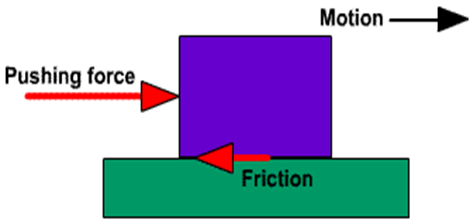 ‘Friction’ is a force that resists motion of sliding or rolling of one object moving relative to another. It is a result of the electromagnetic attraction between the charged particles of two touching surfaces.
‘Friction’ is a force that resists motion of sliding or rolling of one object moving relative to another. It is a result of the electromagnetic attraction between the charged particles of two touching surfaces.
Friction is defined as the resistance offered by the surfaces that are in contact when they move past each other.
For example, we use car brakes when we want to stop or slow down because of the friction between the brakes and the wheels that slow/stop the car.
Factors Affecting Friction
Friction is a force that is dependent on external factors and there are the two factors due to friction depend:-
1. On the nature of the two surfaces that are in contact:-
Friction depends on the smoothness or roughness of the two surfaces in contact with each other. If the surface is smooth, the friction between the two is reduced because there is little locking of the bumps. If the surface is rough, friction increases.
2. On the force that is acting on these surfaces:-
Friction increases when the force is applied along with the irregularities.
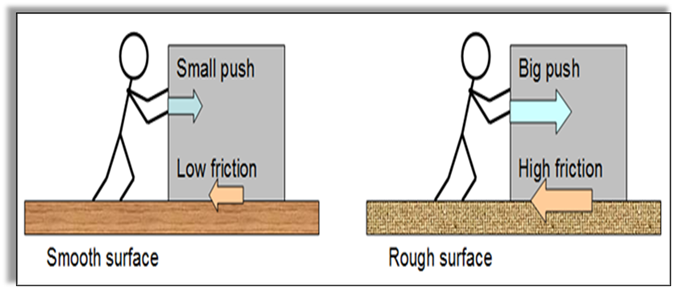
TYPES OF FRICTION
Following are the friction types which depend on the types of motion:
- Static Friction
- Sliding Friction
- Rolling Friction
- Fluid Friction
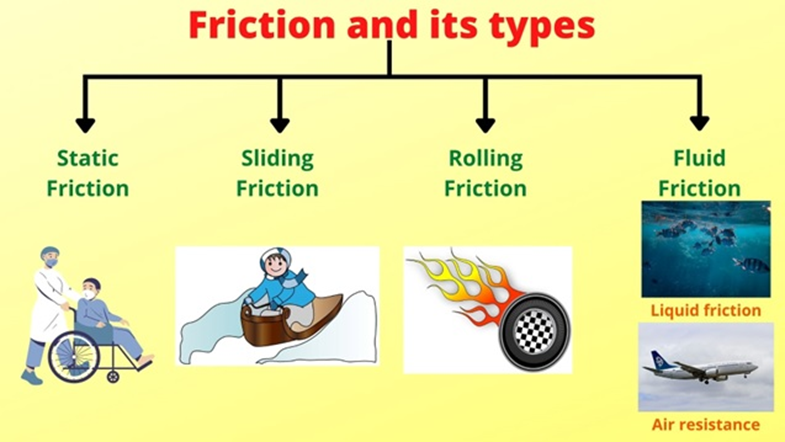
STATIC FRICTION
Static friction is defined as the frictional force that acts between the surfaces when they are at rest with respect to each other.
The magnitude of the static force is equal in the opposite direction when a small force is applied to it. As the force increases, at some point the maximum static friction is reached.
Static Friction Examples
Following are the examples of static friction:
- Skiing against the snow
- Creating heat by rubbing both the hands together
- Table lamp resting on the table
Laws of Static Friction
- The maximum force of static friction is not dependent on the area of contact.
- The maximum force of static friction is comparable to the normal force, that is, as the normal force increases, so does the maximum external force that the object can withstand without moving.
Limiting Friction:
This is the maximum value of static friction that occurs when an object begins to slide over the surface of another object. If the external force is greater than the limiting friction, the body begins to move.
Once the motion has started, static friction cannot be considered. A new type of friction termed askinetic frictioncomes into play.
Laws of Limiting Friction:
- The direction of limiting frictional force is always contrary to the direction of motion.
- Limiting friction acts tangentially to the two surfaces interacting.
- The magnitude of limiting friction is proportional to the normal reaction between the two surfaces.
- The limiting friction hinges upon the material, the nature of the surfaces interacting and their evenness.
- So long as the normal reaction is the same, the magnitude of limiting friction is free of the shape or the area of the surfaces in contact for any two given surfaces.
Coefficient of Static Friction-
The coefficient of static friction is denoted µs. The maximum force of the static friction factor is given as the product of the static friction factor and the normal force, and the product of the static friction force is less than or equal to the product of the static friction factor and the normal force. It is given as follows:
|
Fsmax=µsη and Fs≤µsη |
Where,
- Fsis the force of static friction
- µsis the coefficient of static friction
- η is the normal force
- Fsmaxis the maximum force of static friction
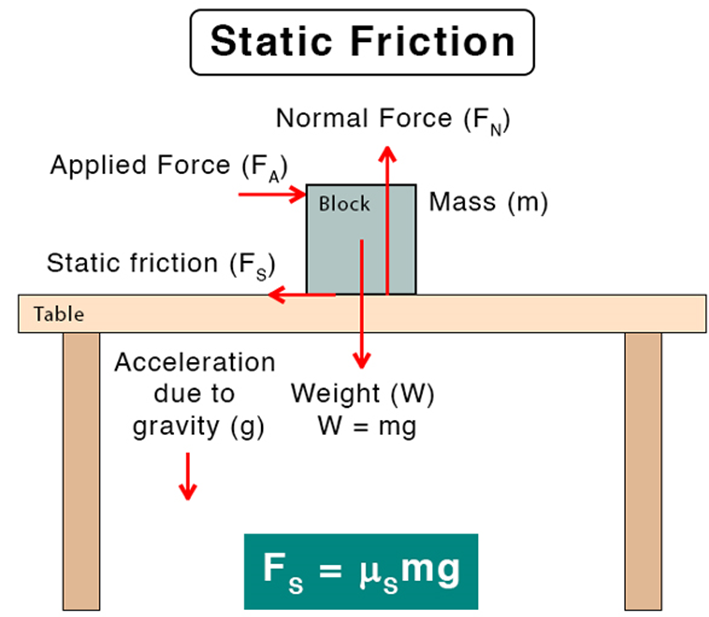
SLIDING FRICTION
Sliding friction is defined as the resistance that is created between any two objects when they are sliding against each other.
This friction is also called kinetic friction and is defined as the force required to slide a surface along another surface. It depends on two variables - one is the material and the other is the weight of the object. A change in the contact area does not change the sliding friction. In most materials, sliding friction is less than static friction. There are exceptions, which include metals, which have static and sliding coefficients of friction, and these are essentially the same at small surfaces where molecular attractions take over.
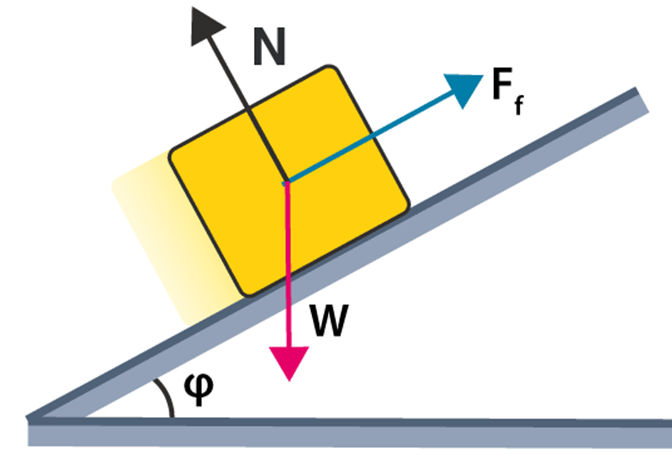
Sliding Friction Examples
Following are the examples of sliding friction:-
- Sliding of the block across the floor
- Two cards sliding against each other in a deck
- A coaster sliding against a table.
- A washing machine pushed along with the floor.
- The frame and the edge of the door sliding against one another.
Factors affecting sliding friction
- The surface deformation of objects.
- The roughness or smoothness of the surface of the objects.
- The original speed of either object.
- The size of the object.
- Finally, the amount of pressure on either object.
Coefficient of Sliding Friction-
The coefficient of sliding friction is denoted asµs. The force of sliding friction is defined as the product of the coefficient ofsliding frictionand the normal force. It is given as:
|
Fs=µs.Fn |
ROLLING FRICTION
Rolling friction is defined as the force which resists the motion of a ball or wheel and is the weakest types of friction.
The force preventing the movement of a rolling object on a surface is called rolling friction or rolling resistance. A ball or wheel rolling on the ground is an example of rolling friction.
Laws of Rolling Friction
There are three laws of rolling friction:
- With the increase in smoothness, the force of rolling friction decreases.
- Rolling friction is expressed as a product of load and constant to the fractional power.
F = kLn
- Rolling friction force is directly proportional to load and inversely proportional to the radius of curvature
F =$\mu\times\frac{W}{r}$μ×Wr
Cause of Rolling Friction
When an object is rolled on a surface, at that time certain things happen like given below:
- The object is deformed at the point of contact with the surface.
- The surface is deformed at the point of contact with the object.
- The motion is created below the surface as a result of the above-mentioned points.
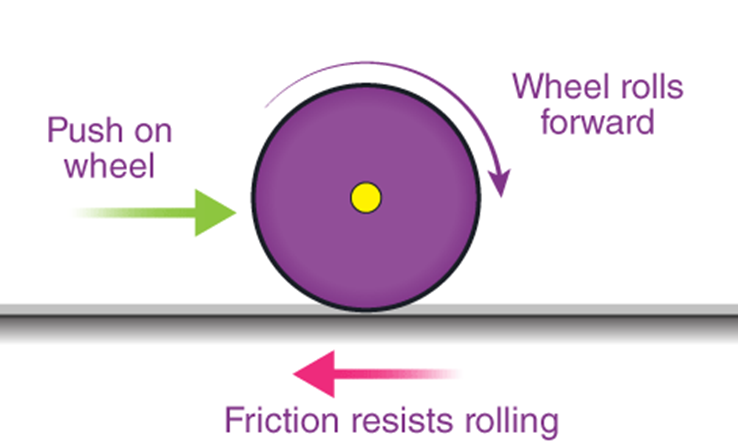
The reason for this friction is that the deformation energy is greater than the recovery energy. In addition, there is an adhesive force between two surfaces that must be constantly overcome. The amount of friction depends on several factors, such as:The quality of the sliding body
- The quality of the sliding body
- The quality of the surface
- Load
- The diameter of the rolling object
- The surface area of the body
Examples of Rolling Friction
Following are the examples of rolling friction:
- Rolling of the log on the ground
- Wheels of the moving vehicles
Coefficient of Rolling Friction-
The coefficient of rolling friction is denoted asµr. The force of rolling friction is defined as the product of the coefficient ofrolling frictionand the normal force. It is given as:
|
Fs=µr.Fn |
DIFFERENCE BETWEEN ROLLING FRICTION AND SLIDING FRICTION
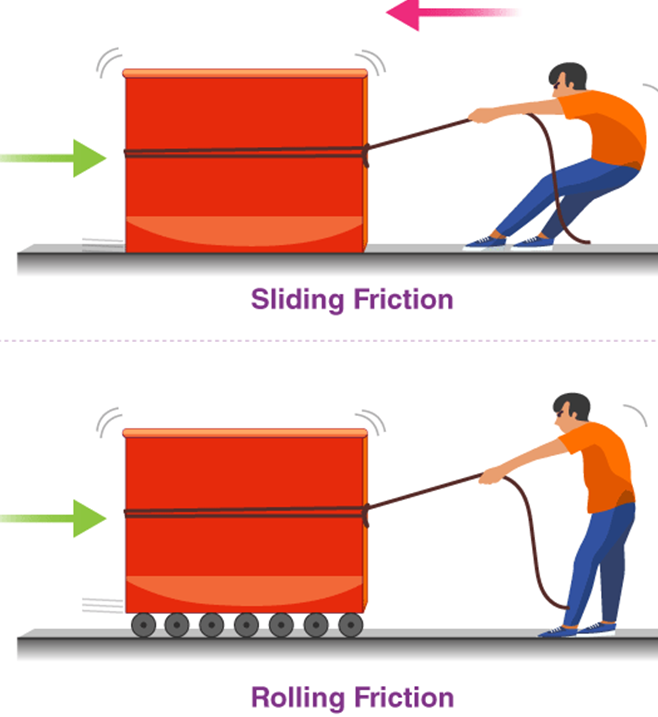
|
Rolling friction |
Sliding friction |
|
Rolling friction takes place when an object rolls on the surface. |
Sliding friction takes place when two surfaces are rubbed against each other. |
|
Rolling friction takes place due to the deformation of surfaces. |
Sliding friction takes place due to interlocking between microscopic surfaces. |
|
The coefficient of rolling friction is dependent on the radius of the rolling object, the depth to which the object can sink, and the toughness of the surface. |
The coefficient of sliding friction depends on the texture of the surface and temperature to a certain extent. It is independent of external factors. |
|
Coefficient of rolling friction: |
Coefficient of sliding friction: |
|
Fr=μrN |
Fk=μrN |
FLUID FRICTION
Fluid friction is defined as the friction that exists between the layers of the fluid when they are moving relative to each other.

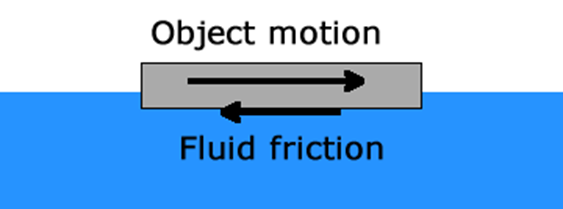
Examples of Fluid Friction
Following are the examples of fluid friction:
- If there is a wet surface between two thin glass plates, you will notice that plates get stuck and the bottom plate doesn’t fall when you hold only the top one.
- When any object is dropped in a fluid, the extent of the splash is depended on the fluid friction of that particular fluid.
- Lighter dust particles can be found moving on the surface of a fast flowing river. This is due to the high velocity gradient in the uppermost water layer due to the lower dynamic fluid friction in that layer.